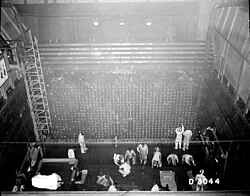1930s
- 1931
- On January 2, Ernest Lawrence and M. Stanley Livingston complete the first cyclotron , a type of circular particle accelerator. This early design is only 4.5 inches in diameter and yields a maximum proton energy of 80 keV. [2] [3]
- 1932
- On January 1, Harold Urey, Ferdinand Brickwedde, and George M Murphy publish the discovery of deuterium. It is spectroscopically identified following separation from a sample of cryogenic liquid hydrogen at Columbia University, New York. [4] [5] Like all nuclei, preceding the discovery of the neutron, it is assumed to be composed entirely of protons and hypothetical "nuclear electrons".
- On February 27, James Chadwick publishes the discovery of the neutron, identified as the "beryllium radiation" emitted under alpha-particle bombardment, previously observed by Irène Joliot-Curie and Frédéric Joliot-Curie. [6]
- On April 30, John Cockcroft and Ernest Walton publish the first disintegration of an atomic nucleus, popularly described as splitting the atom. They report the production of two alpha particles from the bombardment of lithium-7 nuclei by protons, using a Cockcroft–Walton generator at the University of Cambridge's Cavendish Laboratory. [7] While in lithium this reaction is exothermic, nucleus disintegration is distinct from the undiscovered process of fission, which induces a radioactive decay.
- 1934
- On June 24, Leo Szilard files the first patent for a nuclear reactor. The design, which predates the discovery of fission, resembles an accelerator-driven subcritical reactor, suggesting deuteron beam fusion interacting with indium, beryllium, bromine, or uranium as neutron-rich core materials. [8]
- Mikhail Alekseevich Eremeev completes the first cyclotron in the Soviet Union and in Europe, at the Leningrad Physico-Technical Institute. It is a small design based a prototype by Lawrence, with a 28 cm diameter capable of achieving 530 keV proton energies. [9] [10]
- 1935
- In January, Vemork hydroelectric plant in Norway operates the first large-scale heavy water production site, pioneered by Leif Tronstad. [11]
- 1937
- In March, V. N. Rukavishnikov, Lev Mysovskii and Igor Kurchatov complete the first MeV cyclotron in the Soviet Union and in Europe, and outside the United States, at the V. G. Khlopin Radium Institute in Leningrad. It is a 100 cm (39 in) accelerator capable of achieving 3.2 MeV proton energies. [12] [13]
- On April 3, Yoshio Nishina, Tameichi Yasaki, and Sukeo Watanabe complete the first cyclotron in Japan and in Asia, at the Riken laboratory in Tokyo. It is a 26-inch accelerator capable of achieving 2.9 MeV deuteron energies. [14] [15]
- 1938
- In August, Niels Bohr, George de Hevesy, and August Krogh complete the first cyclotron in Denmark, at the Institute for Theoretical Physics of the University of Copenhagen. [16]
- 1939
- On February 11, Lise Meitner and Otto Frisch publish the discovery of nuclear fission, [17] collaborating with Otto Hahn and Fritz Strassmann who previously identified barium following neutron bombardment of uranium, at the Kaiser Wilhelm Institute for Chemistry, Berlin. [18] Meitner and Frisch, both Jewish, had already fled Nazi Germany to Stockholm and Copenhagen respectively, and were barred from co-publishing with their German colleagues under Nazi anti-Jewish legislation.
- On March 8, Hans von Halban, Frédéric Joliot-Curie, Lew Kowarski, and Francis Perrin submit for publication the first net neutron production in an atomic pile. [19] The experiment in Ivry-sur-Seine, Paris uses a 50-cm copper sphere filled with a uranyl nitrate water solution and a radium-beryllium neutron source.
- On March 16, Herbert L. Anderson, Enrico Fermi, and H B Hanstein submit for publication the first pile neutron production in the United States, from pile Columbia number 1 at Columbia University, New York. The pile submerges a 13-cm glass bulb filled with uranium oxide in water acting as a moderator and reflector. [20]
- In March, Frédéric Joliot-Curie achieves a 7 MeV proton beam at the first cyclotron in France, at the Collège de France in Paris. [21] [22]





















